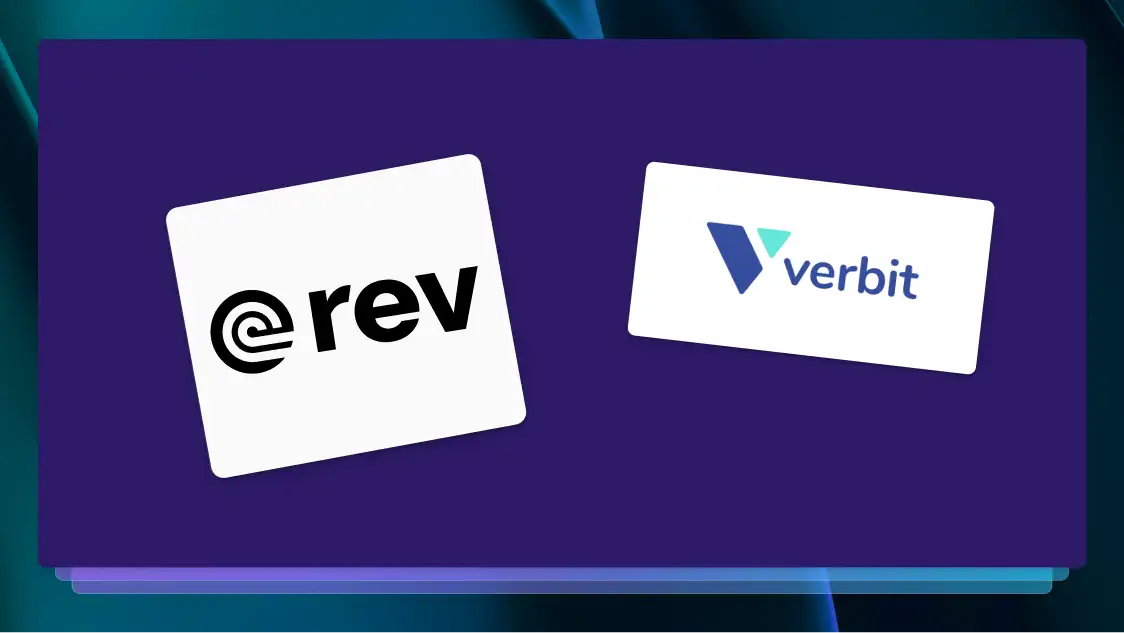National Speech-Language-Hearing Month: 13 Ways to Improve Your Company’s Accessibility
Use these 13 tips to improve your company’s accessibility during National Speech-Language-Hearing Month, and join the annual celebration!

Every May, Better Hearing and Speech Month is celebrated — and this time, with a new name! Get ready to celebrate the all-new National Speech-Language-Hearing Month of 2025 and bring awareness to issues surrounding speech and hearing accessibility. With a new and improved title, this annual month-long event is ready to embrace the rebirth of spring by inspiring change in communities across the globe.
Here at Rev, we consider ourselves experts in making content more inclusive by creating transcriptions that are reviewed by humans for humans, and there’s nothing we love more than giving speech-language-hearing accessibility its time in the sun.
Below, you’ll find a list of 13 ways to make accessibility front and center at your company. Plus, we’ve included advice on hearing loss prevention and facts that will make you rethink the way you view accessibility both at work and in your day-to-day life.
National Speech-Language-Hearing Month Ideas: 13 Ways To Improve Your Company’s Accessibility
There are many ways for small business owners, CEOs, and even content creators to increase their accessibility efforts during National Speech-Language-Hearing Month. To start brainstorming, here are 13 ways to improve your company’s accessibility for those with speech or hearing conditions:
1. Caption and Transcribe Your Company’s Video and Audio Content
Bridge the gap between your viewers or listeners and the content you’re creating. Use trusted caption or transcription services for videos and audio content, especially podcasts, so anyone can follow along with ease.
2. Hire A Sign Language Interpreter
Sign language interpreters are invaluable for occasions where captions simply aren’t an option. Hire an interpreter for meetings and live events to accommodate your deaf or hard-of-hearing attendees.
3. Provide Assistive Learning Devices (ALDs)
Another way to make events and workplaces more inclusive is by providing assistive learning devices or ALDs. These may include sound-transmitting systems like hearing loops, which are especially useful in theaters or large conference halls where acoustics can be unfavorable.
4. Make Written Content Accessible
Rethink your written content by including accessible formats like braille and large print, and don’t forget to make your written digital content more accessible by using high-contrast colors and appropriate text sizing for better readability.
5. Offer Free or Discounted Screenings
There’s nothing that tells your employees you care for their well-being like providing free healthcare screenings. Help your staff detect speech or hearing issues early by offering free or discounted screenings by a qualified healthcare provider.
6. Raise Awareness on Social Media
This month is your chance to engage with your local speech and hearing community. Use social media to promote awareness of National Speech-Language-Hearing Month and highlight any local causes, such as new laws or the addition of ADLs in public spaces.
7. Invest in Accessible Alert Systems
Safety should be a priority for everyone in your workspace. Replace your standard alarm systems with visual or vibrating alert systems, which could be a lifesaving move for your hard-of-hearing employees.
8. Use Inclusive Web Design
Make your website visitors comfortable from the very first click. Your website should follow inclusive design principles, including the use of alternative text for photos and videos that can be read by screen readers.
9. Follow Web Content Accessibility Guidelines
Speaking of web design principles, there’s an easy way to test how your website ranks. Ensure you’re following the Web Content Accessibility Guidelines (WCAG) by answering a series of testable statements that can help you determine where your site has room for improvement.
10. Partner With Local Organizations
Want to advocate for change at a larger level? There are plenty of ways for your company to get involved, including partnering with local advocacy groups to promote equal rights and improve accessibility for those in your community.
11. Record Your Meetings
Your deaf or hard-of-hearing employees will appreciate recordings of your meetings, and it’s also an excellent way to keep your entire team on the same page. To step up your game, add captions or create transcripts with the help of a speech-to-text service.
12. Train Your Employees on Inclusivity
National Speech-Language-Hearing Month is an excellent time to set up workshops and training sessions to get your employees up to speed on your latest inclusivity practices, including changes in company protocol and other similar holidays, like Deaf Awareness Month.
13. Ask Your Employees for Feedback
The best way to know what your employees need is simply to ask. Request feedback from your team on the different ways your company could improve accessibility, including suggestions from this list to get their ideas flowing.
What Is the Purpose of National Speech-Language-Hearing Month?
The purpose of National Speech-Language-Hearing Month, formerly called Better Hearing and Speech Month, is to increase awareness surrounding issues of accessibility for those with hearing and speech disorders.
These issues may include access to closed captioning on safety instruction videos, sign language interpretation for live events, or the regulation of assistive technologies. Additionally, the month promotes access to early detection and intervention for hearing and speech disorders, as well as advocacy for accessibility in the workplace.
What is the New Name of Better Hearing and Speech Month?
As of 2024, Better Hearing and Speech Month will be known as National Speech-Language-Hearing Month. The change was made official by the National Association for Hearing and Speech Action (NAHSA), the consumer affiliate of the American Speech-Language-Hearing Association (ASHA), on July 19, 2023.
History of the Holiday: 100 Years of Tradition
The early 20th century was a period of innovation and discovery in speech-language and audiology studies, with medical advances that required outside financial support. To garner this support, National Speech-Language-Hearing Month was established in 1927 by the American Speech-Language-Hearing Association (ASHA), only two years after the ASHA itself was founded.
For the last 100 years, the event has skyrocketed into a global initiative, hailed by communities big and small. Each year, this annual event has brought attention to critical issues of accessibility, putting matters into the hands of those who can make a difference at both the local and national levels.
Facts About Better Hearing and Speech Month
Here are some unique facts about this all-important holiday that you might not know:
- More than 48 million Americans experience hearing loss. (HLAA)
- Approximately 1 in 12 (7.7%) U.S. children between the ages of 3 and 17 years old have voice, speech, or language issues, or related issues with swallowing. (NIDCD)
- Hearing loss is the third most common chronic physician condition in the U.S., right behind high blood pressure and arthritis. (CDC)
- Tinnitus, which is characterized by a ringing noise in the ears that can lead to serious health issues, is common among 10 to 25% of adults. (NIDCD)
- Around one in four adults in the U.S. above the age of 65 experience disabled hearing loss, and the effects only worsen with age. (NIDCD)
- Only 20% of those who could benefit from using a hearing aid have one. (HLAA)
- Approximately 17.9 million Americans suffer from voice disorders including hoarseness and complete loss of voice, which both require specialized voice therapy. (NIDCD)
- Advanced AI technologies and transcriptive services can play a critical role in creating better opportunities for children with hearing or speech disabilities. (NCBI)
Why Prioritizing Accessibility Is Crucial
By making your products, services, and workspaces more accessible to those with speech and hearing conditions, your company has everything to gain. With satisfied employees who feel accommodated and appreciated, your company will be less susceptible to turnover, which can come with expensive staff training costs. Not only can accessibility boost worker satisfaction and productivity, but it can also open you up to a whole new customer base.
How To Care for Your Hearing Health
Anyone can be impacted by speech or hearing issues, and it’s easy to take advantage of the many accessibility options currently available. You may not be experiencing speech or hearing issues yourself right now, but you never know how resources like closed captioning and hearing aids could help you in the future.
To keep your hearing health in tip-top shape, here are six tips you can start following immediately:
1. Avoid Loud Noises
You may love attending concerts or using big, loud power tools, but don’t forget the safety of your ears in the process. If you simply can’t live without standing right next to the speaker at the dance club, at the very least, grab yourself some earplugs and step away for regular breaks.
2. Schedule Hearing Check-Ups
When was the last time you had a hearing check-up? Just like regular check-ups at the doctor, it’s important to schedule hearing check-ups to monitor the strength of your hearing and catch any issues early before they turn into bigger problems.
3. Keep Your Ears Clean
There’s a reason your doctor says to avoid Q-tips! When you “clean” your ear with cotton swabs, you’re only pushing wax in deeper, which can lead to long-term damage. Instead, leave your ears dry and, if needed, use an ear wax softener or consult a professional to remove buildup.
4. Don’t Overuse Headphones
Do you listen to loud music on your headphones or earbuds 24/7? Be mindful — you might be causing more damage than you think. Take breaks and try noise-canceling headphones, which can help you cut out background noise and decrease the need to have your volume up high.
5. Learn to Enjoy Silence
There’s nothing wrong with a little silence every so often. Find a relaxing, quiet environment and give your ears a rest. Take a walk in the forest, spend the afternoon in a sleepy cafe, or lay out by the pool. No music, no podcasts, no conversation — just the joy of peace and stillness.
6. Pay Attention to Your Body
If your body is telling you there’s a problem, listen. It’s important to note any signs of discomfort or changes in your hearing, or if you’re having trouble understanding speech. If you hear a ringing sound in your ears, it could be a sign of tinnitus, so contact your doctor immediately.
Celebrate National Speech-Language-Hearing Month With Cutting-Edge Transcription Services
For over a century, National Speech-Language-Hearing Month has contributed to countless campaigns in the fields of speech, language, and hearing sciences. From advances in speech recognition software to the development of hearing aids and cochlear implants, things have changed drastically over the last 100 years.
Want to contribute to that change? This May, make your company part of the tradition by expanding your accessibility with closed captioning and transcription services. At Rev, our linguists use advanced AI technology to give you fast, accurate, and easy-to-read captions and transcriptions for your video and audio content. Join us in making the next century a renaissance in communication and inclusivity!
Learn more about other important holidays, like Learning Disabilities Awareness Month, on our blog.
Check out Rev’s closed captioning services or subscribe today!















